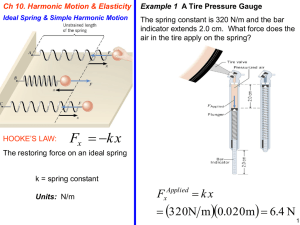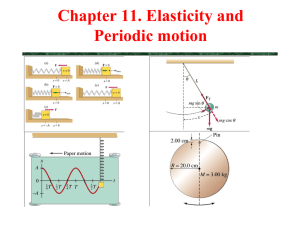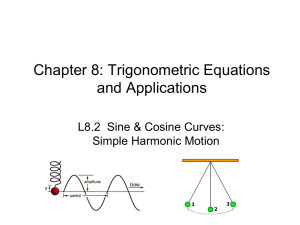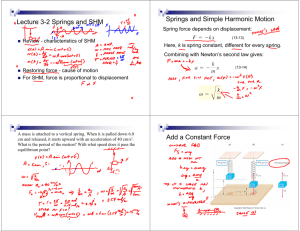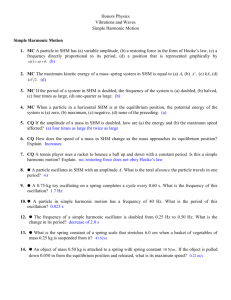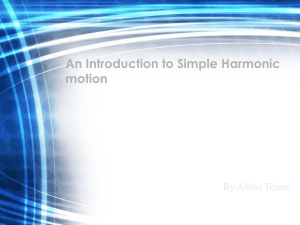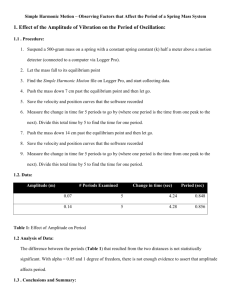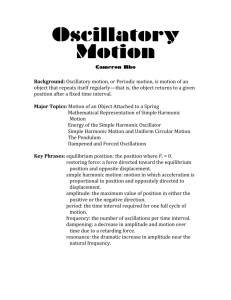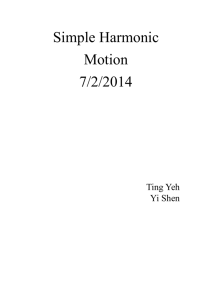Oscillatory Motion Lecture: SHM, Springs, Damping, Resonance
advertisement
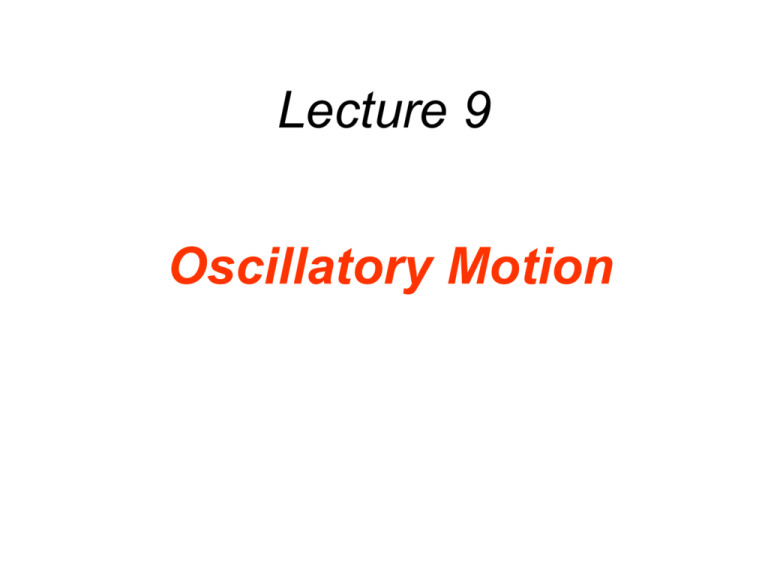
Lecture 9 Oscillatory Motion Outline 1. Periodic motion, simple harmonic motion (oscillator) 2. Ideal spring, Hooke’s law and natural frequency of oscillation 𝜔 = 𝑘 𝑚 𝑑2 𝑥 𝑑𝑡 2 3. Equation of motion: + 𝜔2 𝑥 = 0 and general solution 𝑥 𝑡 = 𝐴 𝑐𝑜𝑠 𝜔𝑡 + 𝜙 1. the two arbitrary constants A, 𝜙 determined from initial conditions 𝑥 0 = 𝑥0 and 𝑣 0 = 𝑣0 2. Simple harmonic motion = projection of uniform circular motion with angular speed 𝜔, radius(amplitude) 𝐴, and initial phase 𝜙 4. Energy of SHM and other examples (pendulum etc.) 5. Damped harmonic oscillation 6. Forced/driven harmonic oscillation and resonance 10.1 The Ideal Spring and Simple Harmonic Motion Applied x F kx spring constant Units: N/m ออกแรงภายนอกด้วยมือที่กระทากับสปริ ง เพื่อให้สปริ งยืดหรื อหด ในรู ปจะเห็นว่างานของแรงนี้เป็ นบวก (การกระจัดทิศทางเดียวกันกับแรง) 10.1 The Ideal Spring and Simple Harmonic Motion HOOKE’S LAW: RESTORING FORCE OF AN IDEAL SPRING The restoring force on an ideal spring is Fx k x ส่ วนแรงคงตัวของสปริงทิศทางตรงกันข้ามและขนาดของแรงแปรผันตรงกับ ระยะยืดหรื อหดของสปริ ง 𝑥 = 𝑙 − 𝑙0 โดยเราเรี ยกค่าคงที่การแปรผันนั้นว่า 𝑘 (ค่าคงที่ของสปริ ง) ในรู ปจะเห็นว่างานของแรงสปริ งนี้เป็ นลบเสมอ คือ การกระจัดจากตาแหน่งสมดุล (หรื อความยาวปกติของสปริ ง) ทาให้พลังงานศักย์สปริ งมี ค่าเป็ นบวก 10.1 The Ideal Spring and Simple Harmonic Motion Conceptual Example : Are Shorter Springs Stiffer? ตัดสปริงให้ ส้ั นลงทำให้ สปริงเหนียวขึน้ ? A 10-coil spring has a spring constant k. If the spring is cut in half, so there are two 5-coil springs, what is the spring constant of each of the smaller springs? 10.2 Simple Harmonic Motion and the Reference Circle DISPLACEMENT x A cos A cos t 10.2 Simple Harmonic Motion and the Reference Circle x A cos A cos t 10.2 Simple Harmonic Motion and the Reference Circle amplitude A: the maximum displacement period T: the time required to complete one cycle frequency f: the number of cycles per second (measured in Hz) 1 f T 2 2 f T 10.2 Simple Harmonic Motion and the Reference Circle VELOCITY v x vT sin A sin t vmax 10.2 Simple Harmonic Motion and the Reference Circle Example The Maximum Speed of a Loudspeaker Diaphragm The frequency of motion is 1.0 KHz and the amplitude is 0.20 mm. (a) What is the maximum speed of the diaphragm? (b) Where in the motion does this maximum speed occur? 10.2 Simple Harmonic Motion and the Reference Circle v x vT sin A sin t vmax (a) vmax A A2 f 0.20 10 3 m 2 1.0 103 Hz 1.3 m s (b) The maximum speed occurs midway between the ends of its motion. 10.2 Simple Harmonic Motion and the Reference Circle ACCELERATION ax ac cos A 2 cos t amax 10.2 Simple Harmonic Motion and the Reference Circle FREQUENCY OF VIBRATION x A cos t a x A 2 cos t F kx ma x kA mA 2 k m 10.2 Simple Harmonic Motion and the Reference Circle Example A Body Mass Measurement Device The device consists of a spring-mounted chair in which the astronaut sits. The spring has a spring constant of 606 N/m and the mass of the chair is 12.0 kg. The measured period is 2.41 s. Find the mass of the astronaut. 10.2 Simple Harmonic Motion and the Reference Circle k mtotal mtotal k 2 2 f mtotal mastro k mchair mastro 2 2 T k mchair 2 2 T 2 606 N m 2.41 s 12.0 kg 77.2 kg 4 2 2 T 10.3 Energy and Simple Harmonic Motion A compressed spring can do work. 10.3 Energy and Simple Harmonic Motion Welastic F cos s 12 kxo kxf cos 0 xo x f Welastic 12 kxo2 12 kx2f 10.3 Energy and Simple Harmonic Motion DEFINITION OF ELASTIC POTENTIAL ENERGY The elastic potential energy is the energy that a spring has by virtue of being stretched or compressed. For an ideal spring, the elastic potential energy is PEelastic 12 kx2 SI Unit of Elastic Potential Energy: joule (J) 10.3 Energy and Simple Harmonic Motion Conceptual Example Changing the Mass of a Simple Harmonic Oscillator The box rests on a horizontal, frictionless surface. The spring is stretched to x=A and released. When the box is passing through x=0, a second box of the same mass is attached to it. Discuss what happens to the (a) maximum speed (b) amplitude (c) angular frequency. ในรู ป ก. เรายืดสปริ งจากตาแหน่ง x(0)=A แล้วปล่อย (v(0)=0) ซึ่ง เมื่อกล่องเคลื่อนที่ผา่ นตาแหน่งสมดุล x=0 จะเคลื่อนที่ดว้ ย 𝑣max ถ้ าเรา ปล่อยให้อีกกล่องหนึ่งตกลงไปติดกับมวลเดิม (มองว่าเหมือนเป็ นก้อนดิน น้ ามันหรื อทรายตกลงไปแปะก็ได้) ดังรู ป ข. ถามว่าหลังมีมวลมาติด เกิด อะไรขึ้นกับ 1. 𝑣max 2. amplitude 3. angular frequency Homework: Vertical Spring A 0.20-kg ball is attached to a vertical spring. The spring constant is 28 N/m. When released from rest, how far does the ball fall before being brought to a momentary stop by the spring? ให้ความยาวปกติของสปริ ง(ค่าคงที่สปริ ง k) เป็ น 𝑙0 มวล 𝑚 อยูใ่ ต้สนามโน้มถ่วง 𝑔 ถ้าปล่อยมวลจากหยุดนิ่งและความยาว สปริ งปกติ ถามว่า ก. ระยะสมดุลใหม่ ℎ𝑒𝑞 อยูท่ ี่ไหน ข. ระยะยืดมากที่สุด ℎ0 (ระยะที่ลูกบอลตกลงมาจาก จุดเริ่ มต้นจนถึงจุดที่ลูกบอลหยุดชัว่ ขณะ) ค. เขียน y(t), v(t) ง. What is amplitude 𝐴 and initial phase 𝜙? Summary of SHM 2 2 ƒ T T 2 m k ƒ Math: definition of period (periodic function COS and SIN) 1 2 k m Physics: What determines the period/frequency of SHM ? x(t ) A cos (t ) dx v A sin( t ) dt d 2x a 2 2 A cos( t ) dt General form of the solution to the differential equation: 𝑥 𝑡 = 𝐵1 cos 𝜔𝑡 + 𝐵2 sin 𝜔𝑡 arbitrary constants 𝐵1 and 𝐵2 are determined by the 2 initial conditions at t=0 𝑥 0 = 𝑥0 , 𝑣 0 = 𝑣0 𝑣0 𝑥 𝑡 = 𝑥0 cos 𝜔𝑡 − sin 𝜔𝑡 𝜔 𝑥02 + 𝑣02 /𝜔 2 −𝑣0 𝜙 = arctan( ) 𝜔𝑥0 𝐴= All of these results are easily understood in terms of “Energy of SHM” 𝟏 𝟐 𝟏 𝑬𝒕𝒐𝒕𝒂𝒍 = 𝒌𝒙𝒎𝒂𝒙 = 𝒎𝒗𝟐𝒎𝒂𝒙 𝟐 𝟐 𝟏 𝟏 𝟏 𝟏 𝟏 𝟏 = 𝒌𝑨𝟐 = 𝒌 𝒙 𝒕 𝟐 + 𝒎𝒗 𝒕 𝟐 = 𝒌𝒙𝟐𝟎 + 𝒎𝒗𝟐𝟎 = 𝒎𝝎𝟐 𝑨𝟐 𝟐 𝟐 𝟐 𝟐 𝟐 𝟐 SHM Example 1 From graph 1. initial conditions: x(0)=A, v(0)=0 2. What is ? 3. Write x(t), v(t), a(t)? •The acceleration reaches extremes of 2A at ±A. •The velocity reaches extremes of A at x = 0. Section 15.2 SHM Example 2 From graph 1. Given initial conditions: 𝑥(0) = 0, 𝑣(0) = 𝑣0 2. What is , A ? 3. Write x(t), v(t), a(t)? The graph is shifted one-quarter cycle to the right compared to the previous graph of x(0) = A. Section 15.2 Importance of Simple Harmonic Oscillators •Simple harmonic oscillators are good models of a wide variety of physical phenomena. •Molecular example – If the atoms in the molecule do not move too far, the forces between them can be modeled as if there were springs between the atoms. – The potential energy acts similar to that of the SHM oscillator. Potential energy 𝑟0 actual P.E. Near equilibrium position 𝑟0 where U (Potential energy) is minimum, approximate P.E. as that of spring 𝑈 = 1 𝑈𝑚𝑖𝑛 + 𝐾 𝑟 − 𝑟0 2 2 + higher order terms in 𝑟 − 𝑟0 3 SHM and Circular Motion •The particle moves along the circle with constant angular velocity •OP makes an angle with the x axis. •At some time, the angle between OP and the x axis will be t + •The points P and Q always have the same x coordinate. 𝑥 𝑡 = 𝐴 cos(𝜔𝑡 + 𝜙) •This shows that point Q moves with simple harmonic motion along the x axis. Section 15.4 SHM and Circular Motion, 4 •The angular speed of P is the same as the angular frequency of simple harmonic motion along the x axis. •Point Q has the same velocity as the x component of point P. •The x-component of the velocity is v = - A sin ( t + ) Section 15.4 SHM and Circular Motion, 5 •The acceleration of point P on the reference circle is directed radially inward. •P ’s acceleration is a = 2A •The x component is –2 A cos (t + ) •This is also the acceleration of point Q along the x axis. Section 15.4 10.4 The Pendulum A simple pendulum (ลูกตุ้มอย่ างง่ าย) consists of a particle attached to a frictionless pivot(จุดหมุน) by a cable of negligible mass. g L mgL I (small angles only) (small angles only) d 2 g g sin 2 dt L L 10.4 The Pendulum Example Keeping Time เรำมักใช้ คำบของลูกตุ้มเป็ นมำตรฐำนเวลำ(นำฬิ กำคุณปู่ ) หรื อ กำรสั่ นของผลึกควอตซ์ ในนำฬิ กำ หรื อแม้ แต่ นำฬิ กำอะตอมก็คือกำรสั่ นของอิเล็กตรอนในอะตอมนั่นเองทีเ่ รำอ่ ำนจำกสั ญญำนแสง เลเซอร์ Determine the length of a simple pendulum that will swing back and forth in simple harmonic motion with a period of 1.00 s. 2 2 f T g L T 2g L 4 2 T 2 g 1.00 s 9.80 m s 2 L 0.248 m 2 2 4 4 2 10.5 Damped Harmonic Motion In simple harmonic motion, an object oscillated with a constant amplitude. In reality, friction or some other energy dissipating mechanism is always present and the amplitude decreases as time passes. This is referred to as damped harmonic motion. Damped Oscillation: model •One example of damped motion occurs when an object is attached to a spring and submerged in a viscous liquid. •The damping/retarding force due to viscosity can be modeled as 𝑏 is a constant called the damping coefficient 𝑭𝒅𝒂𝒎𝒑𝒊𝒏𝒈 = −𝒃𝒗 Section 15.6 Damped Oscillations •The amplitude decreases with time. •The dashed lines represent the envelope of the motion. Section 15.6 Damped Harmonic Motion F ma d 2x a 2 dt , F kx d 2x kx m 2 dt simple harmonic motion พิจารณา แรงหน่วง (damping force) dx Fdamping bv dt dx d 2x kx b m 2 damped harmonic motion dt dt d 2x dx m 2 b kx 0 dt dt d 2x dx b k 2 2 2 x 0 , , dt 2 dt 2m m 34 10.5 Damped Harmonic Motion • • • • SHM with no damping Under-damped SHM Critically-damped SHM Over-damped SHM A,B เป็ นค่าคงที่ 10.6 Driven Harmonic Motion and Resonance When a force is applied to an oscillating system at all times, the result is driven harmonic motion. Here, the driving force has the same frequency as the spring system and always points in the direction of the object’s velocity. Driven(forced) harmonic motion F F0 cos f t แรงภายนอก dx d 2x kx F0 cos f t m 2 dt dt driven harmonic motion forced d 2x dx m 2 kx F0 cos f t dt dt ผลเฉลยของสมการ 𝑥 𝑡 = 𝐴 cos(𝜔𝑓 𝑡 − 𝛼) คาดการณ์ผลเฉลย (particular solution)ว่า วัตถุจะสัน่ ด้วยความถี่ 𝜔𝑓 เดียวกันกับแรงกระตุ้น แต่แอมพลิจูด 𝐴 กับ เฟส 𝛼 จะต่างจาก ของแรงกระตุน้ จากภายนอก 𝑣 𝑡 = A 𝑑 𝑥 𝑡 = −𝜔𝑓 𝐴 𝑠𝑖𝑛(𝜔𝑓 𝑡 − 𝛼) 𝑑𝑡 F0 m 2 f 02 arctan 2 f 2 4 2 2f 02 2 f 37 10.6 Driven Harmonic Motion and Resonance RESONANCE Resonance is the condition in which a time-dependent force can transmit large amounts of energy to an oscillating object, leading to a large amplitude motion. Resonance occurs when the frequency of the force matches a natural frequency at which the object will oscillate. Resonance •When the frequency of the driving force is near the natural frequency (f 0) an increase in amplitude occurs. •This dramatic increase in the amplitude is called resonance. •The natural frequency 0 is also called the resonance frequency of the system. •At resonance, the applied force is in phase with the velocity and the power transferred to the oscillator is a maximum. – The applied force and v are both proportional to sin (t + ). – The power delivered is F.v • This is a maximum when the force and velocity are in phase. • The power transferred to the oscillator is a maximum. Section 15.7 Resonance, cont. •Resonance (maximum peak) occurs when driving frequency equals the natural frequency. •The amplitude increases with decreased damping. •The curve broadens as the damping increases. •The shape of the resonance curve depends on b. Section 15.7 10.7 Elastic Deformation (ไม่ ออกสอบโดยตรง แต่ ควรรู้ว่าเป็ นทีม่ าของกฎของฮุค ) Because of these atomic-level “springs”, a material tends to return to its initial shape once forces have been removed. ATOMS FORCES 10.7 Elastic Deformation STRETCHING, COMPRESSION, AND YOUNG’S MODULUS L A F Y Lo equivalent to 𝐹 𝑌𝐴 where 𝐾 = 𝐿 = 𝐾 ΔL 0 Young’s modulus has the units of pressure: N/m2 Stress, Strain and Hooke’s Law In general the quantity F/A is called the stress. The change in the quantity divided by that quantity is called the strain: V Vo L Lo x Lo HOOKE’S LAW FOR STRESS AND STRAIN Stress is directly proportional to strain. Strain is a unitless quantitiy. SI Unit of Stress: N/m2 ส่ วนที่เกิดการยืดแบบ Plastic deformation ส่ วนที่ประพฤติตามกฎของฮุค (แรงแปรผันตรงกับระยะยืด) 10.7 Elastic Deformation Example Bone Compression In a circus act, a performer supports the combined weight (1080 N) of a number of colleagues. Each thighbone of this performer has a length of 0.55 m and an effective cross sectional area of 7.7×10-4 m2. Determine the amount that each thighbone compresses under the extra weight. 10.7 Elastic Deformation L A F Y Lo FLo 540 N 0.55 m 5 L 4 . 1 10 m 9 2 4 2 YA 9.4 10 N m 7.7 10 m 10.7 Elastic Deformation SHEAR DEFORMATION AND THE SHEAR MODULUS x F S A Lo The shear modulus has the units of pressure: N/m2 10.7 Elastic Deformation 10.7 Elastic Deformation Example J-E-L-L-O You push tangentially across the top surface with a force of 0.45 N. The top surface moves a distance of 6.0 mm relative to the bottom surface. What is the shear modulus of Jell-O? x F S A Lo FLo S Ax 10.7 Elastic Deformation FLo S Ax 0.45 N 0.030 m S 460 N 2 3 0.070 m 6.0 10 m m2 10.7 Elastic Deformation VOLUME DEFORMATION AND THE BULK MODULUS V P B Vo The Bulk modulus has the units of pressure: N/m2 10.7 Elastic Deformation

